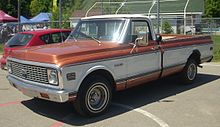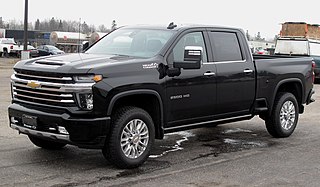
The Chevrolet Silverado is a range of trucks manufactured by General Motors under the Chevrolet brand. Introduced for the 1999 model year, the Silverado is the successor to the long-running Chevrolet C/K model line. Taking its name from the top trim level from the Chevrolet C/K series, the Silverado is offered as a series of full-size pickup trucks, chassis cab trucks, and medium-duty trucks. The fourth generation of the model line was introduced for the 2019 model year.

The Chevrolet C/K is a series of trucks that was manufactured by General Motors from the 1960 to 2002 model years. Marketed by both the Chevrolet and GMC divisions, the C/K series encompassed a wide range of vehicles. While most commonly associated with pickup trucks, the model line also included chassis-cab trucks and medium-duty trucks and served as the basis for GM full-size SUVs. Through its entire production, the model line competed directly against the Ford F-Series and the Dodge D series.
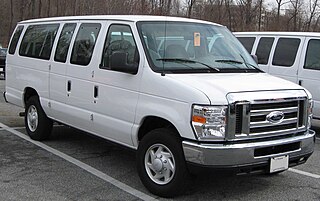
The Ford E-Series is a range of full-size vans manufactured and marketed by the Ford Motor Company. Introduced for 1961 as the replacement of the Ford F-Series panel van, four generations of the model line have been produced. Marketed for both cargo and passenger transport configurations, the E-Series has been designed with multiple design variations for both retail and commercial sale, including vans, and commercial-grade cutaway van chassis and stripped chassis.

The Chevrolet Suburban is a series of SUVs built by Chevrolet since the 1935 model year. The longest-used automobile nameplate in the world, the Chevrolet Suburban is currently in its twelfth generation, introduced for 2021. Beginning life as one of the first metal-bodied station wagons, the Suburban is the progenitor of the modern full-size SUV, combining a wagon-style body with the chassis and powertrain of a pickup truck. Alongside its Advance Design, Task Force, and C/K predecessors, the Chevrolet Silverado currently shares chassis and mechanical commonality with the Suburban and other trucks.

The Chevrolet Express is a series of full-size vans produced by General Motors since 1996. The successor to the Chevrolet G-series van, the Express is produced in passenger and cargo variants. Alongside the standard van body, the line is offered as a cutaway van chassis; the latter vehicle is a chassis cab variant developed for commercial-grade applications, including ambulances, buses, motorhomes, and small trucks.
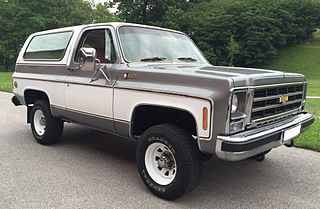
The Chevrolet K5 Blazer is a full-size sport-utility vehicle that was built by General Motors. Being GM's smallest full-size SUV, the K5 Blazer is part of the C/K truck series. Introduced to the Chevrolet line for the 1969 model year, the K5 Blazer was replaced for 1995 by the Chevrolet Tahoe. In 1970, GMC introduced its own model of the truck, called the Jimmy, which was discontinued in 1991 and replaced by the Yukon. The "Jimmy" name was chosen to reflect how GM may sound in a similar manner to how Jeep was thought to be a pronunciation of GP in the competing market. Both were short-wheelbase trucks and available with either rear- or four-wheel drive. Despite all Chevrolet versions from 1969 to 1988 having the "K5" badge, GM never internally referred to the model as the K5 Blazer/K5 Jimmy. Officially, the vehicles have always been referred to as the Blazer/Jimmy, without the K5 prefix. After the release of the S-Series Blazer/Jimmy in 1983, the models were officially renamed "Chevrolet Full-Size Blazer" and "GMC K-Jimmy", though they are often unofficially still addressed as "K5" to avoid confusion.
Flint Assembly is an automobile factory operated by General Motors in Flint, Michigan. It is the city's only vehicle assembly plant after the closure of Buick City. Flint Truck Assembly is also GM's oldest, still operating assembly plant in North America. As of 2022, the Flint factory currently produces full-size pickup trucks. Engine block and cylinder heads were cast at Saginaw Metal Casting Operations, internal engine components were created at Bay City Powertrain and Grand Rapids Operations, and the engines were then assembled at Tonawanda Engine and Romulus Engine. For most of the 20th century Flint Assembly was the home factory for all Chevrolet vehicles.
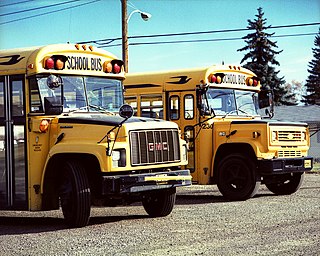
The Chevrolet and GMC B series was a series of cowled chassis that were produced by General Motors. Produced across three generations from 1966 to 2003, the model line was a variant of medium-duty trucks marketed under the Chevrolet and GMC nameplates. Initially derived from the medium-duty C/K series, later examples were derived from the GMT530 architecture.

The Chevrolet Kodiak and GMC TopKick are a range of medium-duty trucks that were produced by the Chevrolet and GMC divisions of General Motors from 1980 to 2009. Introduced as a variant of the medium-duty C/K truck line, three generations were produced. Slotted between the C/K trucks and the GMC Brigadier Class 8 conventional, the Kodiak/TopKick were developed as a basis for vocationally oriented trucks, including cargo haulers, dump trucks, and similar vehicles; on later generations, both cutaway and cowled-chassis variants were produced for bus use.

The International Harvester Travelall is a model line of vehicles that were manufactured by International Harvester from 1953 to 1975. One of the first competitors of the Chevrolet Suburban, the Travelall was a truck-based station wagon, serving as a forerunner of modern people carriers and full-size sport utility vehicles.
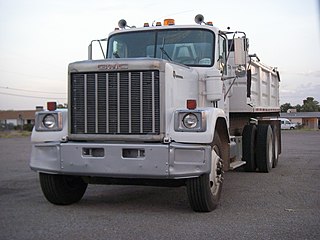
The GMC General is a heavy-duty truck that was assembled by the GMC Truck and Coach Division of General Motors from 1977 to 1987. The largest conventional-cab truck ever produced by the company, the product line replaced the C/M 90/9500 trucks.

The GMC Brigadier is a series of heavy-duty trucks that were assembled by the GMC Truck and Coach Division of General Motors. The second generation of the H/J-series heavy-duty conventionals, the Brigadier was produced from 1978 to late 1989, as a WhiteGMC for the last year and a half. Slotted between the largest medium-duty C/K trucks and the GMC General, the Brigadier was a Class 7-8 short-hood conventional similar to the Ford L-Series and Mack Model R. Configured in both straight truck and semi-tractor layouts, the Brigadier saw use in short-haul, vocational, and severe-service applications.

The GMC Astro is a heavy-duty cabover truck that was manufactured by the GMC Truck and Coach Division of General Motors from the 1969 to 1987 model years. Succeeding the F/D-series "Crackerbox" cabovers, the Astro was marketed by Chevrolet as the Titan, serving as the largest cabover truck ever produced by General Motors.

The Chevrolet Van or Chevy Van is a range of vans that was manufactured by General Motors from the 1964 to 1996 model years. Introduced as the successor for the rear-engine Corvair Corvan/Greenbrier, the model line also replaced the panel van configuration of the Chevrolet Suburban. The vehicle was sold both in passenger van and cargo van configurations as well as a cutaway van chassis that served as the basis for a variety of custom applications.

The fifth generationof the Ford F-Series is a line of pickup trucks and commercial trucks that were produced by Ford from the 1967 to 1972 model years. Built on the same platform as the fourth generation F-Series, the fifth generation had sharper styling lines, a larger cab, and expanded engine options.

The sixth generation of the Ford F-Series, also known as the "dentside Ford" to enthusiasts, is a line of pickup trucks and medium-duty commercial trucks that were produced by Ford Motor Company from the 1973 to 1979 model years. Produced by Ford in North America, Argentina, and Australia, this is the third and final generation of trucks derived from the 1965 Ford F-Series.
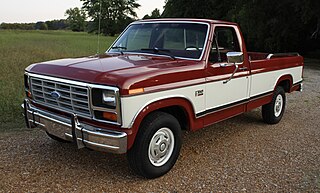
The seventh generation of the Ford F-Series is a range of trucks that was produced by Ford from the 1980 to 1986 model years. The first complete redesign of the F-Series since the 1965 model year, the seventh generation received a completely new chassis and body, distinguished by flatter body panels and a squarer grille, earning the nickname "bullnose" from enthusiasts. This generation marked several firsts for the model line, including the introduction of the Ford Blue Oval grille emblem, the introduction of a diesel engine to the model line, and a dashboard with a full set of instruments (optional). Conversely, this generation marked the end of the long-running F-100, the Ranger trim, and sealed-beam headlamps.

The first generation of the C/K series is a range of trucks that was manufactured by General Motors from the 1960 to 1966 model years. Marketed by both the Chevrolet and GMC divisions, the C/K trucks replaced the previous Task Force generation of trucks. The first General Motors pickup trucks developed on a dedicated truck platform, the C/K series included pickup trucks, chassis-cab trucks, and medium/heavy commercial trucks.

The third generation of theC/K series is a range of trucks that was manufactured by General Motors from the 1973 to 1991 model years. Serving as the replacement for the "Action Line" C/K trucks, GM designated the generation under "Rounded Line" moniker. Again offered as a two-door pickup truck and chassis cab, the Rounded Line trucks marked the introduction of a four-door cab configuration.

The fourth generation of the C/K series is a range of trucks that was manufactured by General Motors. Marketed by the Chevrolet and GMC brands from the 1988 to the 2002 model years, this is the final generation of the C/K model line. In a branding change, GMC adopted the GMC Sierra nameplate for all its full-size pickup trucks, leaving the C/K nomenclature exclusive to Chevrolet.





